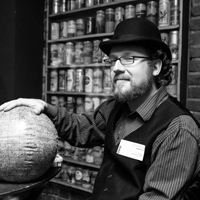Every type of matter has an antimatter partner: electrons are paired with positrons, protons have antiprotons, and for every quark there’s an antiquark. When a particle meets its antiparticle, they annihilate into gamma rays: the highest energy type of light, in accordance with E = mc2.

So what about light: Is there such a thing as an antiphoton?
The answer is yes, but it’s not a fundamentally new particle. Antiphotons are the same thing as regular photons: there’s no difference at all. That might seem disappointing (no antilight for science fiction stories), but the same physics theory that describes the behavior of matter and antimatter predicts that if two high-energy photons collide in the right way, they’ll annihilate into pairs of matter and antimatter particles. However, that theory has never been tested, but it might finally lead to experiments very soon.
A paper published this week in the journal Nature Photonics explained how. O. J. Pike, F. Mackenroth, E. G. Hill, and S. J. Rose showed that if you send gamma rays into a special heated gold chamber known as a “hohlraum,” the photons would annihilate. (Hohlraum is just the German word for “empty room,” in the typical physics habit of giving fancy-sounding terms to simple concepts.) The result would be hundreds of thousands of pairs of electrons and positrons—and an exciting new way to study the interactions between light and matter.
Gregory Breit and John Archibald Wheeler first predicted this photon-photon annihilation in 1934. (Wheeler is best known for popularizing the term “black hole,” though nobody knows where he got the term or if he made it up himself.) The basic concept is simple: if you collide an electron and a positron at relatively low speed, a common outcome is a pair of gamma rays of equal energy. A law of physics says if you run the clock backwards, it should be equally valid: colliding two gamma rays of the right energy should give you an electron and a positron.
The “right energy” is important: visible light doesn’t have nearly enough. Photons have no mass: they’re pure energy, so by E = mc2 there needs to be enough energy in the light to convert into the mass of the electron and positron. Only gamma rays can do it, since all other forms of light are too low-energy.
Electrons and positrons have opposite electric charges, so they happily and fatally attract each other. (We’ve all been in relationships like that.) However, photons are electrically neutral, so their influence on each other is minimal under ordinary circumstances.
That’s where the hohlraum comes in: it’s a gold sleeve heated by laser light to create a kind of gas of photons inside. When the gamma rays enter the sleeve, they interact with that photon gas, annihilating into electron-positron pairs. Using a magnet, experimenters can separate the electrons and positrons at the other end of the sleeve, counting them and measuring their energy.
If the process of annihilating photons is the exact reverse of annihilating electrons and positrons, then the energy of the particles coming out of the hohlraum should follow a distinct pattern. That’s what we expect from quantum electrodynamics: the theory of how light and matter interact. Richard Feynman, Julian Schwinger, and Sin-Itiro Tomonaga, building on earlier work by Wheeler and others, developed quantum electrodynamics—the best-tested and most accurate theory in all of physics.
Nevertheless, there’s still that slight possibility of new behavior any time physicists design new experiments. It’s unlikely, but that’s the reason to make large numbers of electron-positron pairs: it’s enough to spot any anomalies and either verify that quantum electrodynamics is still champion, or see any very small hints that something else is going on.
Beyond that, photon-photon colliders offer a different set of experimental possibilities than typical particle accelerators like the Large Hadron Collider (LHC). For example, electrons and positrons are the lowest-mass particles of ordinary matter (not counting neutrinos, which are governed by different rules). By cranking up the gamma ray energy, it might be possible to make quarks-antiquark pairs, probing the properties of these particles in a new regime.
A few experimental facilities have lasers of the right kind to create photon-photon annihilation, including SLAC in the United States and the Orion laser in the UK. That means it should be possible to test this proposal fairly soon.
Because there’s no mass at the start and the result is electrons and positrons, no experiment could provide a purer example of E = mc2. It would also provide a final test of one of the elementary predictions of quantum electrodynamics, but at the same time open up a new set of possible experiments.
And all of this because light is its own opposite.






